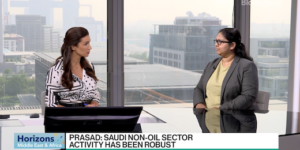Give and Take
Nasser Saidi says Saudi Arabia’s journey towards diversification risks simply being a long wish list if the Gulf state can’t marry reforms with freedoms
With oil prices nose-diving since June 2014, Saudi Arabia (and the other GCC nations) has experienced a sharp drop in economic growth along with rising budget and current account deficits. Faced with higher borrowing costs (and CDS spreads), lower liquidity, and dampened credit growth, Saudi has to undertake major policy reforms for both fiscal consolidation and greater economic diversification.
Long March Forward
The release of its ambitious National Transformation Plan (NTP) confirms that Saudi has chosen the path of shock therapy as opposed to a gradual adjustment policy. The NTP aims to diversify the economy from its dependence on oil and broaden the sources of government revenue. The plan, estimated to cost around SAR 270bn, includes a 110-page list of policies and targets for ministries and governmental bodies for 2016-2020.
Financing will rely on efficiency savings, privatisation and PPP, taxation and spending cuts on existing projects, according to the Minister of Finance. Ranging from cuts in energy, electricity and water subsidies to reducing the public sector wage bill, and taxation, the reform plan is wide ranging and represents an unannounced new social contract.
The NTP is a Saudi’s own “Long March Forward” that will require mass mobilization, public-private cooperation, public buy-in guided by a clear and shared vision and explicit communication strategy, and deep structural reforms supported by macro-fiscal policy reforms. The NTP documents the fact that the leadership is aware of and not afraid to tackle the many challenges facing Saudi Arabia.
The crux of the Saudi reforms is a shift towards a greater role for the private sector in creating a more diversified economy and in job creation for Saudis and away from the current dominance of the state and its agencies. While details of the private sector shift programme remain vague, the plan outlines the aim to increase the number of private-sector jobs by 450k by 2020, in addition to lowering public-sector salaries as a proportion of the budget to 40% from 45%.
Nothing but a wish list?
The NTP aims to address many of the challenges facing Saudi (and other GCC oil-exporters) and offers specific solutions, though the “how” is not always well-defined:
- High youth unemployment rates of around 30%: the plan targets unemployment among Saudis to fall to 9% from 11.6% in the next five years.
- Women and their low labour force participation rates: the aim is to bring a further 1.3m women into the workforce by 2030, increasing female labour participation to 28% from 23% at present, as well as raising number of women in civil service to 42% from 39.8%. However, the NTP is silent on the empowerment of women and their wider role in economic & social development.
- Moving away from subsidised, high energy-intensive activities is necessary for greater diversification; specific targets are set to raise the contributions of real estate, IT, tourism and the defence and pharmaceutical industries to non-oil GDP.
- In a bid to innovate, the NTP hopes to deliver a revolutionary 15% uplift in mathematics and English attainment levels within five years. But to be modern-day relevant, the focus should be on Science, Technology, and Engineering & Mathematics (STEM).
For the NTP the path to greater diversification winds through export-led growth (via improvements in “doing business” and increased local production) and eventually, regional and international integration. But it is also necessary for macroeconomic stability that the stance of monetary & fiscal policy be reversed from pro to counter-cyclical.
More fundamentally, Saudi should use the NTP to liberalise the FDI regime, allow (selective) 100% foreign ownership, an open skies policy, develop domestic financial markets for government deficit financing, development and infrastructure finance and facilitate access to finance for growth-SMEs through FinTech.
The problem with politics is…
Some oil-exporting countries have successfully diversified in the past: Norway, Malaysia, Indonesia and Mexico come to mind. But the external context was different; the shift away from oil was aided by growing globalisation in the 1990s and early 2000s, and it took up to twenty years to sustainably achieve the structural goal of diversification. The current global environment is significantly more challenging amidst slow global & trade growth, GFC hysteresis, the Fed’s hike cycle, and threatening geopolitical risks (think Trump).
Will NTP achieve its stated goals by 2020? Does the Saudi government & its agencies have the institutional capacity to effect a deep economic transformation? Can the private sector adjust to the removal of subsidies, new taxes and other policy reforms while innovating and creating jobs? Can a new social contract be imposed without corresponding political and social adjustments? The road on the Saudi Long March Forward is tortuous and bristles with unknowns. Indeed, there’s many a slip ‘twixt the cup and the lip.
(The article is on Page 14 of the June issue of the Trade & Forfaiting Review journal & can be accessed here)






